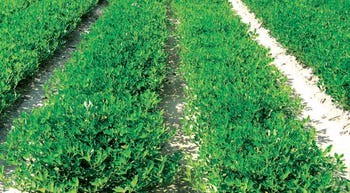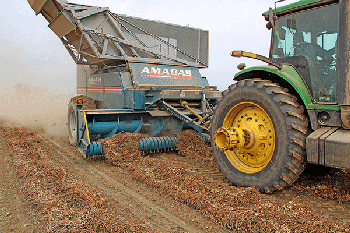
In the Southeast, the probability of receiving 20 inches to 25 inches of rainfall, evenly distributed during the growing season, is very low, says Wesley Porter. "This means non-irrigated peanuts rarely achieve their full potential,” he told members of the Mississippi Peanut Growers Association at their annual meeting.

Thirty percent: That’s how much chance a peanut grower in the Southeast has of getting the water the crop will need during the season to reach its full potential, based on more than 50 years of weather data.
“Looking at it another way, there’s a 70 percent chance you’re not going to receive the rainfall that’s needed to produce optimum yield, particularly during peanuts’ peak water requirement period,” says Wesley Porter, University of Georgia/Auburn University assistant professor and Extension irrigation specialist, who spoke to the annual meeting of the Mississippi Peanut Growers Association.
Peanuts require approximately 23 inches of water from planting to harvest, says Wesley Porter.
“Peanuts require approximately 23 inches of water from planting to harvest,” he notes. “The really important thing to remember is that 18 inches, or 78 percent of that water, is needed from weeks 10 to 17 of the 20-week growing season. In the Southeast, the probability of receiving 20 inches to 25 inches of rainfall, evenly distributed during the growing season, is very low — which means non-irrigated peanuts rarely achieve their full potential.”
Porter says predictive modeling now enables specialists to do “a pretty good job of forecasting the chances of getting particular rainfall events, and this can help us in scheduling irrigation and making decisions about whether to water or hold off.”
Stay current on what’s happening in Mid-South agriculture: Subscribe to Delta Farm Press Daily.
On average, he says, peak daily water use for peanuts is 1.2 inches over the season, but during the peak fruiting period that increases to about 2.1 inches per week. “Our chances of getting this are very, very low. I’m not a gambling man, and with those odds I think if I want to get the most from my peanut crop, I’m going to make the investment in irrigation.”
In making that decision, Porter says, there are several factors to consider in order to get a system that meets the grower’s needs.
Irrigation system efficiency
“Efficiency of irrigation systems ranges from 60 percent to 95 percent. Solid set and traveling gun systems typically range from 60 percent to 65 percent; overhead systems with high pressure nozzles range from 70 percent to 80 percent; overhead systems with low pressure drop nozzles range from 80 percent to 95 percent; and drip systems are typically about 90 or greater percent based on management practices.”

Peak daily water use for peanuts is 1.2 inches over the season, but during the peak fruiting period that increases to about 2.1 inches per week.
Optimally, he says, sensors will be used for precise estimation of soil moisture, and weekly irrigation amounts will be split, if possible. “If you apply more than three-fourths inch at any given time, you’re probably going to have runoff.”
Water stress is usually highest during canopy development, flowering, and fruiting stages on any crop, Porter says. “Water requirements are low until about week 8 or 9; from 9 to 10, about 1 inch per week is needed; from week 12 to 15, peak fruiting, about 2.1 inches per week will be needed, or .3 inch per day. After peak fruiting, water demand starts tapering off.”
Four-year average rainfall at Tifton, Ga., which is representative of most of the Southeast, was 23.6 inches per season. “If we can get a good slow, low intensity rain events evenly distributed, that’s great,” he says. “But where problems occur is when we get spikes of 3 inches to 6 inches, which turn mainly to runoff or when we get really small rains, which mostly evaporate and don’t really help.”
Many growers tend to over-irrigate peanuts, Porter says. “It’s easy to turn on a system and let it run almost continuously during the season, but too much irrigation can reduce the opportunity to maximize profit. Reduced oxygen levels in saturated soil conditions can hinder root growth and cause rapid canopy expansion. So, in many cases, we’re putting on more canopy than fruit.”
Can increase crop profitability
Irrigation scheduling/precision irrigation — determining how much water is needed and when to apply it to meet crop demands — can increase crop profitability by getting maximum efficiency from water and energy, he says. “It’s doing a better job of getting the correct amount of water to the crop at the proper time, while minimizing water losses.”

"I’m not a gambling man…and I think if I want to get the most from my peanut crop, I’m going to make the investment in irrigation.â€â€”Wesley Porter
USDA national surveys, Porter says, show 80 percent of irrigation scheduling is based on visual observation — waiting to see the crop wilting before turning on irrigation. “That’s not a good practice,” he says. “If you’re seeing water stress in the crop, you’re already losing yield potential.”
From 6 percent to 35 percent of producers feel the soil to determine soil moisture. Others irrigate when neighbors irrigate, which he says, “in my opinion is one of the worst strategies you can use. Your neighbor may not have planted at the same time, or may not have planted the same varieties or even the same crops — this is just as bad as the visual analysis method.”
Some use a personal calendar schedule: “I know I have X number of systems and X number of crops and need to get X amount of water on them in a certain amount of time, and I adjust applications according to rainfall events.” Others get daily weather/crop/evapotranspiration reports from the media and adjust irrigations accordingly.
Eight percent or fewer use irrigation scheduling services, computer simulation models, or plant/soil moisture sensors.
Precision irrigation, using variable rate techniques, plant and soil moisture sensors, remote sensing devices, scheduling apps, and zone management techniques can help producers to obtain optimum benefits from water, fertilizer, lime, and other inputs.
“Research shows water is the most important crop input in many areas of the world,” Porter says. Water conservation and water use efficiency “are critical issues.” In some areas, mandatory actions restrict agricultural water use. In some areas, metering of irrigation wells is mandatory. In the Mississippi Delta, faced with a declining water in the alluvial aquifer, a voluntary program of metering wells is being encouraged.
About the Author(s)
You May Also Like



